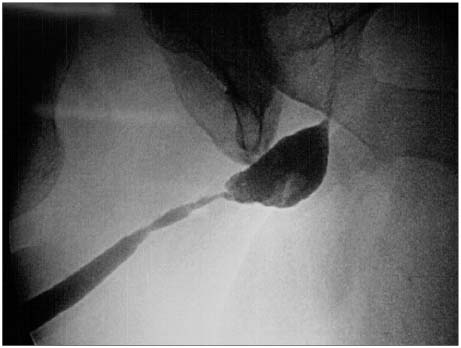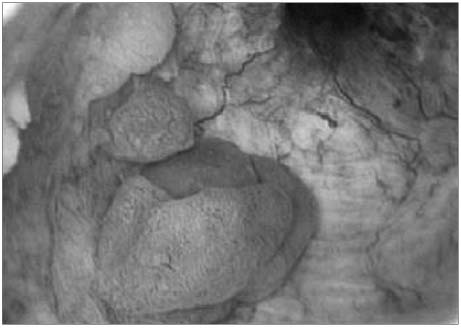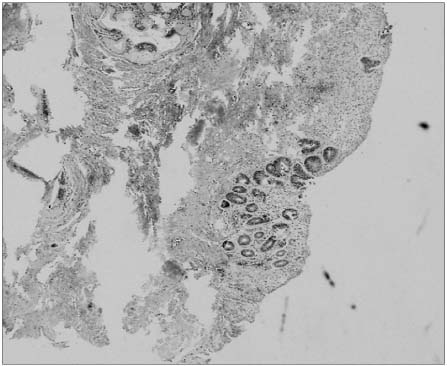Korean J Urol.
2006 Jul;47(7):802-805. 10.4111/kju.2006.47.7.802.
Primary Urethral Adenocarcinoma in a Young Man Who Presented with Voiding Dysfunction
- Affiliations
-
- 1Department of Urology, Korea Cancer Center Hospital, Seoul, Korea. urodori@yahoo.co.kr
- 2Department of Pathology, Korea Cancer Center Hospital, Seoul, Korea.
- KMID: 2294327
- DOI: http://doi.org/10.4111/kju.2006.47.7.802
Abstract
- Primary urethral carcinoma accounts for less than 1% of the malignancies in males and adenocarcinoma accounts for 5% of all urethral carcinomas. A 36-year-old man with a history suggestive of urethral stricture was scheduled to undergo retrograde urethrography and visual urethrotomy. On urethroscopic examination, an abnormal polypoid mass was found in the proximal bulbous urethra, so transurethral resection biopsy was added to the urethrotomy. Histopathologic examination demonstrated urethral adenocarcinoma with no invasion to the corpus spongiosum and cavernosa on the magnetic resonance imaging. There was no evidence of metastasis and the search for the primary focus of adenocarcinoma revealed that the tumor originated from the urethra. The patient underwent segmental urethral resection and there has been no recurrence for 1-year follow-up.
Keyword
MeSH Terms
Figure
Reference
-
1. Ingram EA, DePauw P. Adenocarcinoma of the male urethra with associated nephrogenic metaplasia. Case report and review of the literature. Cancer. 1985. 55:160–164.2. Mostofi FK, Davis CJ Jr, Sesterhenn IA. Carcinoma of the male and female urethra. Urol Clin North Am. 1992. 19:347–358.3. Posso MA, Berg GA, Murphy AI, et al. Mucinous adenocarcinoma of the urethra: report of a case associated with urethritis glandularis. J Urol. 1961. 85:944–948.4. Jefferey C, Applewhite M, Craig H, Davis L. Urethral carcinoma, adult and pediatric urology. 2002. 4th ed. Philadelphia: Lippincott Inc;1791–1798.5. Jin MJ, Lee TY, Kim DH. A case of adenocarcinoma of the male urethra. Korean J Urol. 1992. 33:560–563.6. Yachia D, Turani H. Colonic-type adenocarcinoma of male urethra. Urology. 1991. 37:568–570.7. Farrer JH, Lupu AN. Carcinoma of deep male urethra. Urology. 1984. 24:527–533.8. Johnson DW, Kessler JF, Ferrigni RG, Anderson JD. Low dose combined chemotherapy/radiotherapy in the management of locally advanced urethral squamous cell carcinoma. J Urol. 1989. 141:615–616.9. Baskin LS, Turzan C. Carcinoma of male urethra: management of locally advanced disease with combined chemotherapy, radiotherapy, and penile-preserving surgery. Urology. 1992. 39:21–25.10. Tefilli MV, Gheiler EL, Shekarriz B, de Oliveira JG, Tiguert R, Grignon D, et al. Primary adenocarcinoma of the urethra with metastasis to the glans penis: successful treatment with chemotherapy and radiation therapy. Urology. 1998. 52:517–519.
- Full Text Links
- Actions
-
Cited
- CITED
-
- Close
- Share
- Similar articles
-
- A Case of Anterior Urethral Metastasis from Rectal Adenocarcinoma
- A Case of Primary Urethral Adenocarcinoma in Female
- The Measurement of Minimal Urethral Opening Pressure (Pmuo) in Patients with Benign Prostatic Hyperplasia
- Clinical Value of Voiding Cystourethrography in Complete Urethral Stricture
- A Case of Primary Giant Urethral calculus





